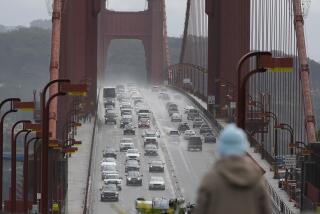Congress OKs Auto Safety Rules for Older Children
- Share via
WASHINGTON — The family car will be safer for preschoolers and older children under legislation approved by Congress and expected to be signed by President Bush.
Named “Anton’s Law” after a 4-year-old killed in 1996 when an adult seat belt failed to hold him in a crash, the bill would set federal auto safety standards for children weighing more than 50 pounds, require carmakers to install shoulder belts in rear center seats and promote research on how best to protect older kids.
In auto-safety parlance, children ages 4 to 8 are known as “forgotten children” because they are too old for conventional child seats, yet their bodies are not big enough to be effectively protected by adult seat belts. The legislation, passed late Monday, aims to close that loophole.
“These children are in danger without some extra kind of protection after they leave that child seat and go on to the adult seat belt,” said Autumn Skeen, Anton’s mother. “This bill is saying, ‘Look, this is a really important aspect of public health.’ ” Skeen, a writer from Walla Walla, Wash., became a safety advocate after her son’s death.
Doctors and safety experts strongly recommend that parents use booster seats for 4- to 8-year-olds who have outgrown conventional child seats.
Most booster seats are essentially pads that let children sit higher in a car so adult lap and shoulder belts do not cut across their stomachs and necks. Emergency-room doctors have documented a pattern of abdominal and neck injuries in children as a result of using adult belts. In severe crashes, lap belts have been shown to cause serious injury to the liver, spleen, intestines and even the spinal cord.
Despite the recognized risks, only 13 states require older children to ride in booster seats. In California, the requirement applies only to children ages 4 to 6.
Sen. Peter Fitzgerald (R-Ill.), the main sponsor of the bill, said he hopes it will save lives by upgrading standards, expanding booster-seat testing and placing new safety rules on automakers.
One of the main provisions of Fitzgerald’s bill would require automakers to install a combination lap and shoulder belt in the rear center seat of all new vehicles, beginning in 2005.
The middle of the back seat is statistically the safest place for a child to ride, but most vehicles have only a lap belt there. A booster seat cannot be used effectively without a shoulder belt.
Federal regulators at the National Highway Traffic Safety Administration have had the authority to require automakers to install full lap and shoulder belts in the middle seat, but they had been reluctant to act without a congressional mandate.
The legislation also would direct the agency to establish new auto-safety standards for booster seats for children weighing more than 50 pounds.
The agency also would have to design and build a crash dummy representing an 80-pound, 10-year-old child, and incorporate it into vehicle safety testing. The U.S. has lagged behind European countries in child-safety testing of autos.
The bill would authorize $5 million for research into whether child seats that are built into a vehicle would prevent more injuries than the seats that parents now have to install.
Last year, 2,588 children ages 15 and under were killed in car accidents. That was the lowest on record, reflecting increased awareness and prevention. Nonetheless, car accidents remain the leading cause of death in childhood.





